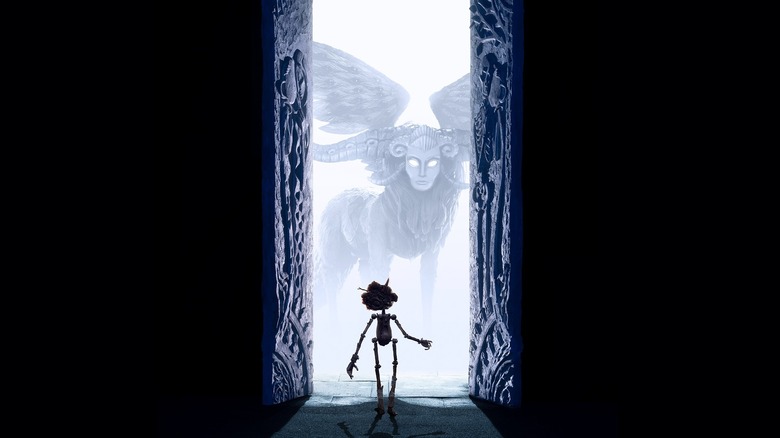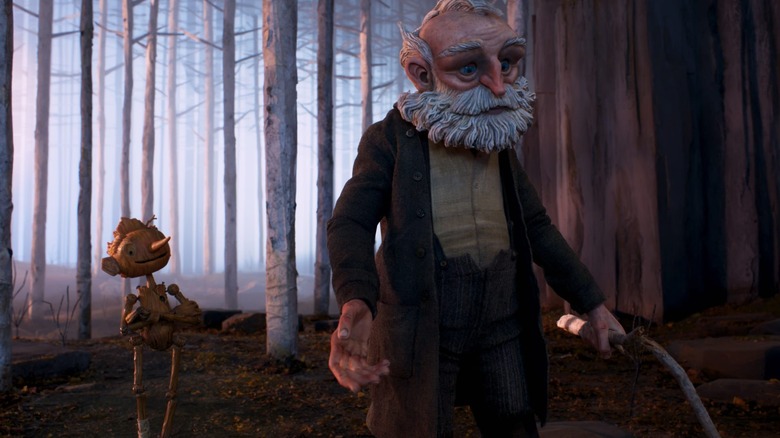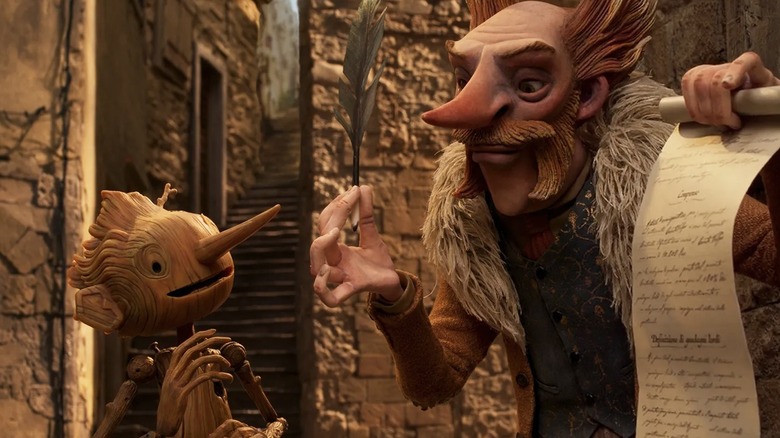Guillermo Del Toro's Pinocchio Review: A Classic Children's Tale Meets Frankenstein And Fascist Italy [London Film Festival]
It's pretty serendipitous that "Guillermo del Toro's Pinocchio" (which del Toro co-directed with experienced stop-motion artist Mark Gustafson) is arriving so shortly after Disney's lifeless live-action remake. It's easy to forget just how ubiquitous the Disney formula — taking classic children's stories and smoothing out the ugly parts, sad endings, and dark corners — has become until you're confronted with an adaptation that refuses to talk down to children or draw a sunny curtain over the terrors of the world.
Hans Christian Andersen's "The Little Mermaid" ends with its young heroine being rejected by her prince and casting herself into the ocean, where her mortal body dissolves into sea foam and she reemerges as a benevolent spirit. Andersen's "The Snow Queen" opens with the devil himself creating a corrupted mirror that shatters; the splinters are blown all around the world and get stuck in people's eyes so that everything they see is twisted into ugliness. In "Grimms' Fairy Tales," Cinderella's stepsisters cut off their toes to try and make them fit the glass slipper, which fills with blood as they attempt to cram their butchered feet into it. You get the idea: stories for children used to be pretty metal.
Carlo Collodi's 1883 novel "The Adventures of Pinocchio" is no exception; methods by which various characters attempt to murder Pinocchio include burning him alive, hanging him, and drowning him. But whereas a Disney adaptation might have sanded off these rougher edges, "Guillermo del Toro's Pinocchio" instead plays a game of "yes, and!"
"Yes, and what if the story was also set in Fascist Italy! And it had a stop-motion Mussolini! And Pinocchio gets press-ganged into a Fascist youth training camp!"
It's fantastic.
Beware; for I am fearless, and therefore powerful
"Guillermo del Toro's Pinocchio" sets the tone right away by telling the story of how old Geppetto (David Bradley) lost his 10-year-old son, Carlo, when a bomb was dropped on a church where Geppetto had been putting the final bloody touches on a grand crucifix. (Religion is another sensitive topic that "Pinocchio" doesn't shy away from.) Years later, Geppetto falls into a mad, drunken, grief-stricken rage and chops down the tree that grew over his son's grave. Determined to defy death and bring Carlo back to him, he skins and chops and chisels until the wood reforms as a clumsily-made wooden puppet, who is imbued with life by a kindly Wood Sprite (Tilda Swinton).
This early sequence benefits from del Toro's experience as a horror director. The creation of the puppet is violent and ominous, and when Pinocchio (Gregory Mann) first greets his horrified father the next morning, his new and unfamiliar limbs twist and flop grotesquely like a monster from "Silent Hill." The first act in particular clearly draws from Mary Shelley's "Frankenstein," whose themes of morality, playing God, and dysfunctional father-son relationships fit quite naturally into this remix with Carlo Collodi's wooden puppet tale.
Confronted with his crimes, Shelley's monster counters that "my heart was fashioned to be susceptible of love and sympathy" and that it was only later "wrenched by misery to vice and hatred." If "Guillermo del Toro's Pinocchio" has a central thesis, it's this: what if Victor Frankenstein hadn't abandoned his creation? What if he'd been offered moral guidance, kindness, and affection? What if he'd been taught right from wrong? Could the creature really have become good instead of evil?
The answer is ... complicated. Not only does "Pinocchio" rewrite Frankenstein's choices, but it also alters the wider world's response from hatred to adoration. Pinocchio is surrounded by eager potential father figures: Geppetto, who is initially uncertain how he feels about his strange wooden son; Sebastian J. Cricket (Ewan McGregor), who takes a break from writing his memoirs to try and guide Pinocchio's heart; sleazy carnival ringmaster Count Volpe (Christoph Waltz), who sees Pinocchio as a "star" ripe for exploitation; and the Podestá (Ron Perlman), a local Fascist official who thinks the living puppet could become the perfect soldier for Benito Mussolini's regime.
As the innocent young Pinocchio cheerfully bounds into the arms of characters with ill intentions, suddenly the simple rules of right and wrong aren't quite so simple. One of the first moral instructions that Sebastian gives to Pinocchio is that in order to be good, he must be obedient. But is obedience really a virtue when you're living under a fascist regime?
Gallows humor — for kids!
If all this sounds pretty dark for a kids' movie ... well, yes, the word "dark" is probably going to be thrown around a lot in relation to del Toro and Gustafson's take on "Pinocchio." But while it might not sound like it, this is actually quite a jolly little film. McGregor is both a grounding element and a source of the film's biggest laughs. Brimming with Bilbo Baggins energy, Sebastian J. Cricket is a pompous little bug with an inflated sense of self-importance who is very disgruntled about his home being disturbed (he moves into the tree just before Geppetto cuts it down to make Pinocchio), and the "Obi-Wan Kenobi" star is delightful in the role.
But the real shining star of the film is young Gregory Mann, who voices Pinocchio with a rambunctiousness and enthusiasm that's enormously endearing and infectious. Whether he's romping around Geppetto's home asking what random objects are used for or cheerfully bursting out of a coffin to greet a group of poker-playing rabbits who serve as the ferrymen of the underworld, Pinocchio is a hugely fun character to follow around, and a perfectly balanced counterweight to the film's mature themes and disturbing moments.
Overall, I wouldn't say "Guillermo del Toro's Pinocchio" is a "dark" movie so much as it is a challenging one — refreshingly so, with knotty, complex questions and real peril. There's a lot for del Toro fans to fall in love with here, particularly when it comes to creature design. The Blue Fairy, for example, is reimagined as the Wood Sprite, whose design draws from the frankly quite terrifying description of angels in the Book of Revelation:
In the center, around the throne, were four living creatures, and they were covered with eyes, in front and in back. The first living creature was like a lion, the second was like an ox, the third had a face like a man, the fourth was like a flying eagle. Each of the four living creatures had six wings and was covered with eyes all around, even under its wings.
Trypophobes, you might want to brace yourselves.
/Film Rating: 9 out of 10


